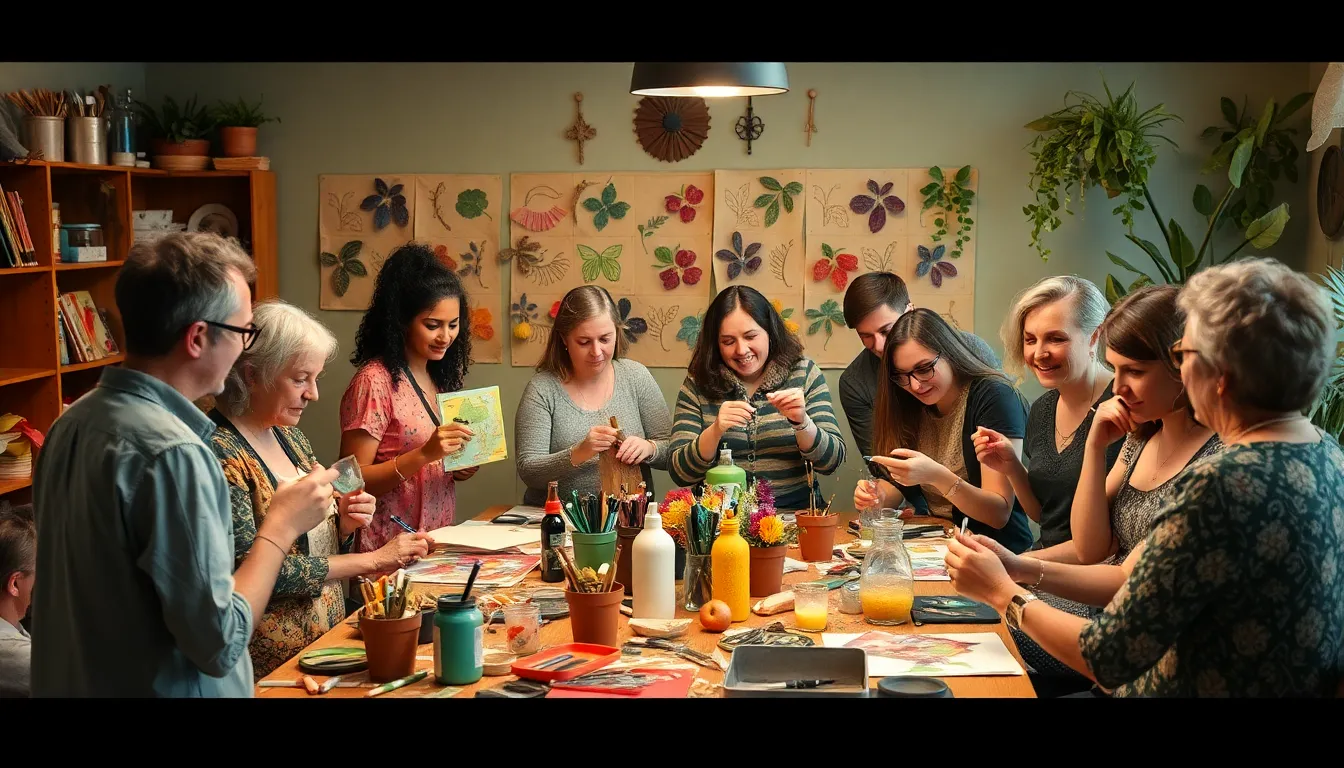In a world where plastic straws have become the villain of the story, eco art projects are the unsung heroes, turning trash into treasure. Imagine walking through a gallery where every piece not only dazzles the eye but also champions Mother Earth. These projects don’t just tickle the creative fancy; they spark conversations about sustainability and environmental stewardship.
From breathtaking sculptures made of reclaimed materials to vibrant murals painted with eco-friendly pigments, eco art is where creativity meets conscience. It’s a delightful blend of artistry and activism, proving that saving the planet can be as fun as a paint-splattered party. Dive into the colorful world of eco art projects and discover how artists are transforming waste into wonders while inspiring us all to think green.
Table of Contents
ToggleOverview of Eco Art Projects
Eco art projects emerged as impactful responses to pressing environmental challenges. Artists transform waste materials, such as plastic straws, into compelling sculptures, demonstrating creativity and sustainability. These initiatives draw attention to the importance of reusing and recycling in artistic expression, fostering a connection between art and environmental advocacy.
Art installations often feature reclaimed items, such as discarded bottles and old furniture, which artists repurpose into striking visuals. Each piece not only captivates viewers but also raises awareness about pollution and sustainable practices. Furthermore, eco-friendly pigments used in murals contribute to a healthier environment while showcasing vibrant colors.
Collaboration plays a key role in many eco art projects. Communities come together to create large-scale works, reinforcing collective responsibility for environmental stewardship. Local workshops teach participants about sustainable practices, empowering individuals to contribute to the art and eco movement.
Exhibition spaces featuring eco art highlight the urgent need for change. Galleries now showcase works that challenge traditional notions of beauty, prioritizing the message of sustainability. Artists utilize their platforms effectively, sparking conversations about climate action and the role of art in driving social change.
Cultivating an eco-conscious mindset, these projects inspire audiences to reevaluate their interactions with the environment. Observers frequently report feeling motivated to adopt greener habits after experiencing eco art firsthand. A blend of artistry and activism offers a fresh perspective on the potential for change through creativity.
Importance of Eco Art

Eco art projects significantly raise awareness about environmental issues. Artists communicate crucial messages about sustainability and conservation through their works.
Environmental Awareness
Innovative eco art projects engage viewers in conversations about pressing environmental challenges. Art pieces crafted from recycled materials serve as visual reminders of waste and its impact. By showcasing the transformation of trash into art, these projects inspire personal reflection on waste reduction. Communities often come together, participating in workshops that demonstrate sustainable practices. The exposure to eco art promotes behavioral changes and a deeper understanding of environmental issues. Collectively, these artistic expressions motivate others to adopt eco-friendly habits and foster a proactive attitude toward the planet.
Cultural Significance
Eco art carries profound cultural implications, intertwining local traditions with contemporary environmental consciousness. Artists draw inspiration from cultural narratives and environmental themes, creating relevance across diverse communities. Projects often reflect the unique ecological challenges faced in specific regions while highlighting the importance of local resources. Community participation enhances cultural identity and collective responsibility for the environment. In many cases, eco art opens dialogues about social justice, heritage, and ecological preservation. This fusion of culture and art cultivates appreciation for the environment, emphasizing the interconnectedness of society and nature.
Types of Eco Art Projects
Various eco art projects emerge, showcasing unique approaches to environmental advocacy. These projects can typically be categorized into community-based initiatives and individual artworks.
Community-Based Initiatives
Community-based initiatives promote collective action through creativity. Local artists often collaborate with residents to create large-scale installations made from recycled materials. These projects foster a sense of ownership and responsibility among community members. Workshops frequently accompany these initiatives, providing hands-on experiences in sustainable practices and art-making. Notable examples include community murals that reflect local environmental challenges, engaging citizens in discussions about climate change. Each artwork functions as a visual call to action, encouraging awareness and participation in eco-friendly behaviors.
Individual Artworks
Individual artworks demonstrate personal expressions of environmental concerns. Artists frequently use everyday waste materials, such as plastic bottles and old furniture, to craft compelling pieces. These artworks challenge viewers to reconsider their relationships with waste and consumption. Through innovative design choices and eco-friendly pigments, artists create pieces that resonate with sustainability. Many artworks are displayed in galleries or public spaces, expanding their reach. Each piece sparks conversation about pressing environmental issues while inspiring viewers to cultivate eco-conscious habits in their daily lives. Individual eco artworks thus become powerful tools for advocacy and reflection.
Materials and Techniques Used
Eco art projects leverage a variety of sustainable materials and innovative techniques to create impactful works. Artists focus on transforming waste into art, highlighting the importance of sustainability.
Sustainable Materials
Recycled plastics serve as a primary medium, offering versatility in sculptures and installations. Discarded fabrics often find new life as vibrant tapestries or collages, showcasing color and texture. Natural elements like wood, stones, and dried herbs enrich the artistic process, emphasizing harmony with the environment. Artists frequently gather materials from local sources, reinforcing community ties and reducing carbon footprints. Utilizing eco-friendly paints derived from naturally occurring pigments further enhances sustainability. Furthermore, artists encourage collaboration by inviting community members to contribute their own waste materials to collective projects.
Innovative Techniques
Innovative techniques play a crucial role in eco art. Artists often employ upcycling, transforming old items into entirely new creations, which sparks creativity and reduces waste. Incorporating new digital technologies creates interactive installations that elevate viewer engagement. For example, augmented reality can overlay digital elements onto physical pieces, generating new narratives. Mixed media approaches allow combining various materials, resulting in striking contrasts and unique textures. In addition, artists sometimes organize workshops to teach these techniques, fostering a sense of shared knowledge.
Notable Eco Art Projects
Eco art projects capture attention through their innovative methods and meaningful messages. These initiatives resonate with audiences, emphasizing sustainability in creative ways.
Project Examples
Prominent projects include “Ocean Sole,” which transforms discarded flip-flops into vibrant sculptures. Artists participating in “The Floating Piers” transformed a lake into walkways, allowing visitors to experience nature artistically. “Trash Islands” engages communities to create installations from ocean debris, raising awareness about marine pollution. Urban art projects utilize recycled materials to craft large-scale murals, depicting local wildlife or environmental issues. These examples collectively highlight creativity’s power in addressing serious environmental challenges.
Impact on Local Communities
Local communities benefit significantly from eco art projects. Many initiatives foster collaboration among residents, encouraging a shared responsibility for environmental stewardship. Participants often learn sustainable practices through hands-on workshops, leading to deeper connections between art and personal actions. Community murals serve as visual reminders of regional challenges, sparking discussions about climate change. Artists’ participation empowers residents to express their cultural identity through art, reinforcing unity and collective action in environmental efforts.
Eco art projects serve as a powerful reminder of the potential for creativity to drive environmental change. By transforming waste into captivating art, these initiatives not only raise awareness but also inspire individuals and communities to rethink their relationship with the environment.
Through collaboration and innovative techniques, artists foster a sense of shared responsibility and cultural identity. The impact of eco art extends beyond aesthetics; it encourages meaningful conversations about sustainability and social justice.
As more people engage with eco art, the movement continues to grow, promoting a greener mindset and encouraging actions that contribute to a healthier planet. Embracing eco art is a step toward a more sustainable future, where creativity and environmental consciousness unite for the greater good.



